
Hart Crane never wrote poems about it, Sonny Rollins practiced sax on the Williamsburg, not the Manhattan, and Steve Brodie never jumped off of it. The Manhattan Bridge has always stood in the shadow of its storied brother to the south, the Brooklyn Bridge.
Probably that’s partially because up until mid-2001, most New Yorkers crossed the Manhattan in a speeding car or subway train, because in true Robert Moses fashion, the bridge was off limits to mere pedestrians. All that recently changed, and we’ll present a series of views of what you can see from the Manhattan, as well as some up close and personal architectural details you might miss when you’re going by at 30 MPH.
The Manhattan Bridge under construction in 1908-1909. Photographer: Eugene de Salignac, from NYC Municipal Archives
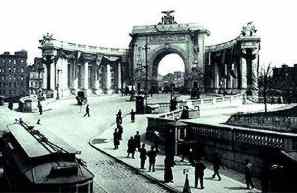
Manhattan Bridge Arch and Colonnade in 1912 from Bowery and Canal Streets
The Manhattan Bridge was the 4th bridge to cross the East River between Manhattan and Long Island. It was finished in 1909 and was started by the partnership of Gustav Lindenthal and Henry Hornbostel, who had built the Queensboro Bridge, finished in 1908. Lindenthal was deposed as the bridge’s architect in 1904 and was replaced by Leon Moisieff, who completed the project.
The massive arch and colonnade that frame the Manhattan at Bowery and Canal Street are the design of Carrere and Hastings, who also built the New York Public Library at 5th Avenue and 42nd Street. They looked to two classic European monuments for inspiration…

Porte St-Denis, Paris, about 1840
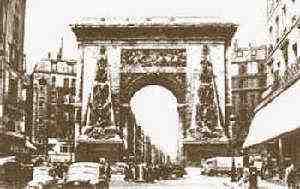
Porte St-Denis, Paris, about 1935
The Porte St-Denis is one of the outstanding triumphal arches in Paris, and one of the oldest. It was raised between 1671 and 1674 to celebrate the military victories of Louis XIV. It is the inspiration for Paris’ more famous Arc de Triomphe, as well as our own Manhattan Bridge Arch.
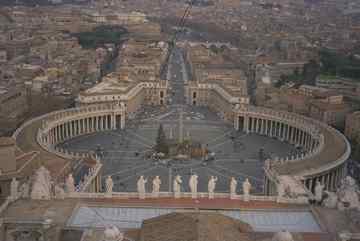
Bernini Colonnade, Vatican City
The horseshoe-shaped colonnade of pillars is based on a European model too: the Giovanni Bernini Colonnade at St. Peter’s in Vatican City, which itself dates to 1656. The gritty Manhattan Bridge entrance has quite the royal pedigree.

photo: Jeff Saltzman
Before we proceed any further on the mighty Manhattan, let’s pause and pay homage to a subject near and dear to my own Forgotten experience: lampposts.
For years, the Manhattan Bridge Arch and Colonnade was allowed to decay and deteriorate and, as the city deferred maintenance for decades, and as the stonework accumulated years’ worth of grime and graffiti, it seemed that the DOT forgot the plaza was even there, since lamppost designs of ages ago were permitted to remain.
“Corvington” longarms, bishop crooks, and Type F lamps of the types formerly seen at the Manhattan end were blithely permitted to ply their trade here well into the 1990s, 40 or more years after they’d been unceremoniously given the boot elsewhere.

Type F “Seventh Avenue”castiron post. This bit the dust in the mid-1990s when the southern Manhattan Bridge walkway was being rehabilitated. Type Fs and ‘gumball’ luminaires are now quite rare in NYC and it was a pity to lose this one.
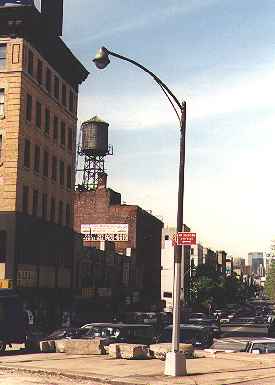

Original 1950s-era octagonal shaft aluminum pole with original curved mastarm and ‘cuplight’ luminaire. These were remobed shortly after I photographed them in 1998.

This photo shows the detailed stonework of the Carrere & Hastings arch, as well as a one-of-a-kind lighting fixture, sporting a ‘gumball’ luminaire. Needless to say this lamp is not there anymore.

By 2001, the Arch and Colonnade were miraculously cleaned and restored, with all of their previous patina of grittiness almost completely washed away. Of course the Menagerie of Lampposts was gone, replaced by a brand-new design apparently created expressly for this plaza. Then new lamps bear a resemblance to the old Type 24A “corvington” longarms, but with a more streamlined look.
But the real reason I was here was to actually cross the Manhattan Bridge on foot, something that hadn’t been possible since the days following World War II (I’m not sure on the exact date when the Manhattan Bridge walkways were closed). The southern walkway was opened in June 2001 while the northern walkway was scheduled to open for bicycles only in 2004.

A quirk on the Manhattan approach is that there is still steelwork in place that was eventually supposed to carry the Lower Manhattan Expressway across the bridge. After years of vehement community operation, the City dropped the plans in 1969.

Apparently no one knows the walkway is indeed open. I encountered few living souls on my perambulation. The newly clean Arch and Colonnade is up ahead.
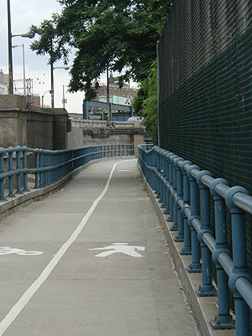
The Bridge is up around the bend….follow the police chalk outlines. (Oh, they’re only bike and pedestrian symbols.)
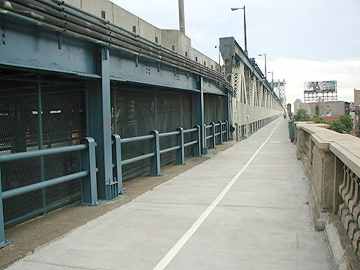
on the Bridge now. Through the opening at left N and Q trains ascend from the tunnel to the bridge. (B and D trains had been banished while endless repairs were effected on the north side of the span.)
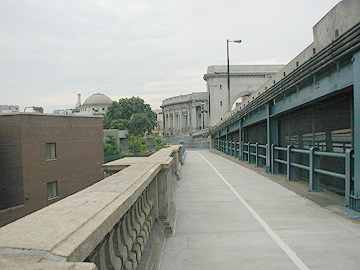
Looking back toward Manhattan we see the Colonnade and Arch at right, and the dome of the old 1924 Citizen’s Savings Bank, now a Republic Bank branch.
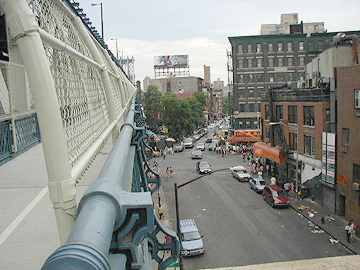
Chicken wire has been rather hastily and slapdashedly installed above the Manhattan’s original low railing to discourage any Steve Brodies or bungee jumpers, but we’d think if they were determined, they’d have no trouble with this flimsy construction. Here a rare break in the fence allows a view of Market Street in Chinatown.

Falun Gong parade, East Broadway


This is the Manhattan side mighty suspension cable anchorage. Ornamentation was still popular when the bridge was constructed, and this is especially in evidence at the pillared stonework seen here.
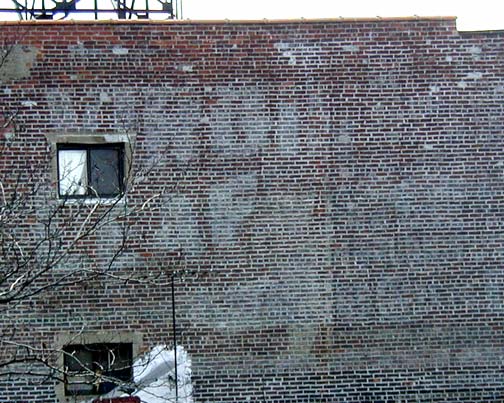
Virgin Leaf tobacco ad, seen from south walkway

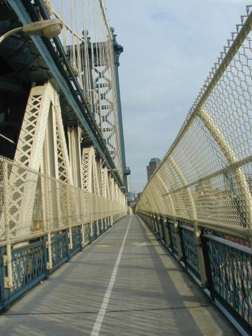
Famed photographer Berenice Abbott shot this midspan view in 1936. Even from these two photos you can see the differing sensibilities of 1936 and the early 21st Century. For example, the ‘city fathers’ pretty much assumed, in the 1910s when the walkway opened, that you wouldn’t want to stray onto the subway tracks and electrocute yourself or be mashed to pulp by a passing train, and you also probably wouldn’t want to jump off the bridge, either, so railings were suitably low. In the 2000’s, of course, all such bets are off and high fencing is the rule.

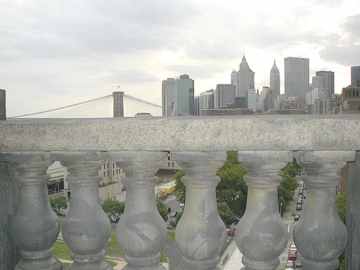
Similarly, the stonework that surrounds each bridge anchorage features a balcony, but they’re protected by high fencing resembling jail bars. Shooting through the bars, you can get a view of NYC nobody has had since the late 1940s at least.

A defunct clock tower, the protective jail bars, and an as-yet unused floodlight at the Brooklyn anchorage.

Sunset over Manhattan Bridge “temporary” fencing. Two months before the towers were destroyed.
According to Norval White, in the AIA Guide to New York City, at one time innovative architect Frank Gehry was consulted on how to spruce up the Manhattan Bridge walkway. I wonder how far he got.

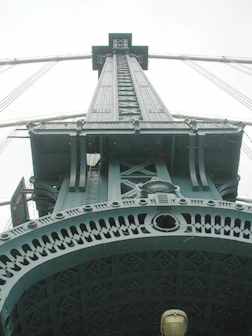
The bridge is architecturally transitional, in that it employs more modern techniques while still holding on somewhat to the ornamentation that was a staple during the Beaux-Arts period. By the time the Verrazano-Narrows Bridge was constructed beginning in the late 1950s, for example, touches like this were considered a waste of money.
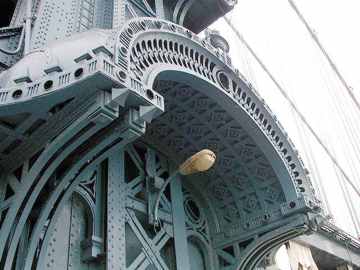
The ornate canopies provide some slight relief if you’re caught in a rain shower while crossing the bridge; otherwise, it’s purely decorative.
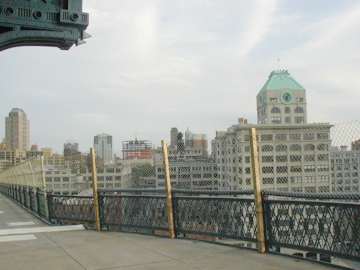
A look at Brooklyn from the Brooklyn-side tower

When I was a kid, the walkways were illuminated by these ‘crescent moon’ luminaires.
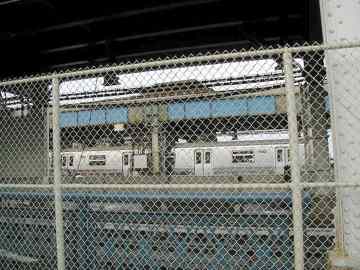
A D train crosses the bridge in mid-2001. Both sides of the Manhattan Bridge are now open to subway traffic for the first time since a brief period in 1990.
Too late, it was discovered that a design flaw in the Manhattan Bridge makes it inadvisable to run subways on its outside edges. It causes the bridge to bend and twist. When two trains are running simultaneously on the north and southbound tracks, the bridge can be depressed by as much as four feet! The Department of Transportation undertook restoration to the stringers on the bridge underneath the tracks as early as the mid 1980s, but the repairs have proven costly and difficult, forcing entire subway lines such as the N on the BMT to be rerouted.
Full service has been restored on the bridge.
So ends our Manhattan Bridge walk. Try it on a clear, brisk, windy day and the views will make you glad you’re a NYer, or glad to be visiting….
Sources:
The Bridges of New York, Sharon Reier, 1977; reprinted 2000 Dover Books
BUY this book at Amazon.COM
As usual the man to turn to for in-depth discussion about NYC’s expressways, parkways and bridges is Steve Anderson; his Manhattan Bridge page is definitive.
7/6/2001, revised 2012

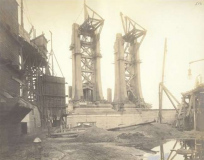
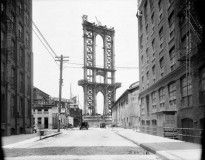
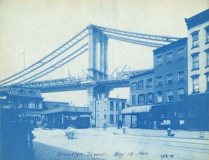
1 comment
See The Naked City TV show episode #72 from 1961. Long opening sequence filmed under the Manhatttan side of the bridge. Other locatios include Greenwich Avenue with Blausteins’s Hardware store, Pouch Terminal in Stapleton, Staten Island. Episode stars Lee J. Cobb.